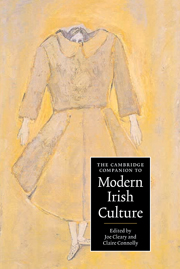Book contents
- Frontmatter
- 1 Introduction: Ireland and modernity
- Part I Cultural politics
- 2 The survival of the Union
- 3 Language, ideology and national identity
- 4 Religion, identity, state and society
- 5 Republicanism, Nationalism and Unionism
- 6 Irish feminism
- 7 Migration and diaspora
- 8 The cultural effects of the Famine
- Part II Cultural practices and cultural forms
- Index
3 - Language, ideology and national identity
from Part I - Cultural politics
Published online by Cambridge University Press: 28 May 2006
- Frontmatter
- 1 Introduction: Ireland and modernity
- Part I Cultural politics
- 2 The survival of the Union
- 3 Language, ideology and national identity
- 4 Religion, identity, state and society
- 5 Republicanism, Nationalism and Unionism
- 6 Irish feminism
- 7 Migration and diaspora
- 8 The cultural effects of the Famine
- Part II Cultural practices and cultural forms
- Index
Summary
Language has operated as a vehicle for debates concerned with cultural identity and political legitimacy in Ireland for much of its modern history. While the incorporation of Ireland into the United Kingdom by the Act of Union of 1800 marks a milestone in the cultural no less than the constitutional history of Ireland, the direction and dynamic of the 'language shift', from Irish to English as the general vernacular, were already well established and, as it seemed, irreversible, by the end of the eighteenth century.
Language and, even more crucially, religion, were the key elements of cultural discrimination in the great convulsion of the sixteenth and seventeenth centuries, the outcome of which was the establishment of a Protestant, overwhelmingly planter, new ruling class in Ireland, together with the triumph of the English language, law and politico-administrative institutions throughout Ireland, and the defeat of the whole institutional edifice of the Gaelic political and social order which had sustained and been mediated through the Irish language.
In the centuries that followed, language, together with religion, remained at the centre of the debate on Irish culture, community and identity. But the language shift to English, the language of power and of all the avenues to advancement, soon gathered momentum among those who aspired to improve their condition or to progress and participate fully in the life of the country under the new order. By the late eighteenth century, Irish was already considered the language of the past and of the poor; not only by the planter society, but by the emerging Catholic middle class in town and countryside, who, while continuing to use Irish in transactions or social intercourse with the lower orders, had themselves made the transition to English as the language of their domestic as well as their public lives. For the literate, Irish was still largely a scribal language of manuscripts, with only a limited presence in the world of print.
- Type
- Chapter
- Information
- The Cambridge Companion to Modern Irish Culture , pp. 42 - 58Publisher: Cambridge University PressPrint publication year: 2005
- 6
- Cited by



